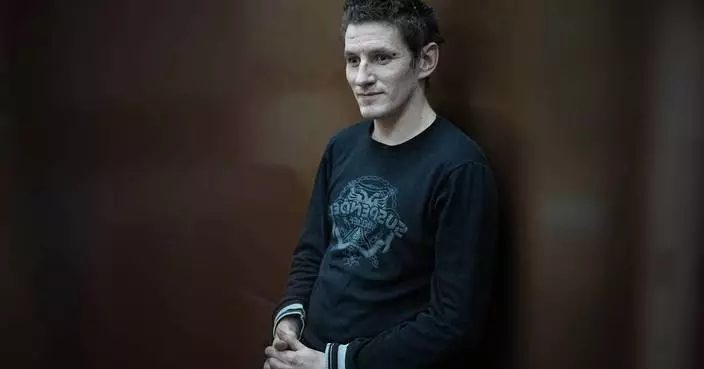A dragon winds around a cherry tree in the tattoo across MJ Hegar's arm and back, over the shrapnel wounds she had, at one point, not wanted to see with her young children around.
But nine years after being shot down in Afghanistan, then winning a lawsuit against the federal government, writing a book and now running for a Texas congressional seat, Hegar isn't hiding much anymore.
"I carry my service with me wherever I go," Hegar said in a telephone interview near her home in Round Rock, outside Austin. "We don't see my family and my childhood and my service as different chapters. It's all a package deal."
Hegar is part of a crop of female veterans running for Congress in this year's midterm elections. Almost all Democrats and many of them mothers, they are shaped by the Sept. 11 attacks and overseas wars, including the longest war in American history. Many are retiring from the military and looking for another way to serve the country.
They're part of a record number of women running for seats in Congress, but in certain ways, they are a class apart.
The female veterans claim expertise in national security and veterans issues, with a track record of thriving in institutions dominated by men. Regardless of party, they cast themselves as the antidote to bitterly partisan politics — describing themselves as "mission-driven" and trained by the military to work toward a common goal.
"I flew 89 combat missions as a U.S. Marine. My 90th mission is running for Congress to take on politicians who put party over country," said Kentucky Democratic candidate Amy McGrath, the first female Marine to fly an F/A-18 in combat.
The increase in candidates with military experience is no accident, and the hopefuls are expected to be propelled by Democratic luminaries. Former Vice President Joe Biden, for example, is expected to campaign for McGrath, among others, according to officials close to them who spoke on condition of anonymity because the schedule is not set.
Two Democrats — Massachusetts Rep. Seth Moulton, a retired Marine Corps captain and Bronze Star recipient, and Illinois Sen. Tammy Duckworth, who lost her legs and partial use of an arm when her helicopter was shot down by a rocket-propelled grenade in Iraq — have been instrumental in recruiting veterans to run for office.
Moulton said female veterans in his party carry a particular authority when talking to voters concerned about President Donald Trump's leadership.
"It's the year of the woman, but it's also the year of yearning for bringing integrity and honor back to politics," Moulton said. "We need Democrats with the credibility to tell people what's really going on."
The women are hardly the first to use their military service to their political advantage — men have been doing it for decades.
One of the traditional knocks against female candidates is "they aren't tough enough, they aren't strong enough, and they might not have the leadership skills," said Debbie Walsh, director of the Center for American Women and Politics at Rutgers University.
Not female candidates who are veterans, particularly of combat.
"They kind of automatically get that kind of respect as leaders; it's well-earned," Walsh said. "It's such a logical next step for people who are committed to this country and are committed to service."
But their campaigns highlight a set of political concerns specific to female veterans.
The candidates acknowledge that their extraordinary stories of trailblazing military careers could make it difficult for some voters to relate to them. Will they come off as too tough or hawkish? Is it possible for any candidate, male or female, to overemphasize his or her military background in the post-9/11 era?
McGrath, who retired as a lieutenant colonel, opened her campaign with an online video in which she wears a bomber jacket, a fighter jet in the background.
McGrath sees herself as a bridge to male voters who "sort of see women as being weaker," she said in a telephone interview. "But yeah, I have to make an effort to reach out to women and make sure that they're not scared, or think that I'm too militant."
Out came a 30-second spot that mentioned the 89 combat missions — but focused on McGrath taking her three children to the pediatrician.
"I'm Amy McGrath and I approved this ad," she says, as her young son takes off down a hallway with his pants down. "Because I'd like to see the other guys running deal with this."
She upset popular Lexington Mayor Jim Gray in the Democratic primary and will take on Republican Rep. Andy Barr in November, a closely watched race considered competitive in a district Barr won by 22 points in 2016. Poised for the different calculus of the general election, Barr last week released an ad quoting McGrath saying of herself, "Hell yeah, I'm a feminist" and calling herself "a progressive."
"Seriously? Is that all you got?" McGrath retorted in a video response, sharing the screen once again with a fighter jet. But this time, she traded her bomber jacket for a denim one.
Much of Hegar's story was already public by the time she decided to challenge Republican Rep. John Carter in the Austin-area district, so she went for the full reveal — tattoos and all.
Her video, "Doors," features the door of the helicopter in which she was shot down on her third tour of Afghanistan as a combat search and rescue pilot. Her medals, including a Purple Heart, play a role, as does Hegar's 2012 lawsuit against the federal government that forced it to repeal the ban on women in combat.
The spot also features an intimate detail: One of Hegar's first memories was of her father throwing her mother through a glass door.
"That's been one of the most difficult transitions for me, is talking about myself more," Hegar said. "I hope that they take away that we have to start putting our faith in people who have a history of putting other people first, fighting against intimidation and bullying, and trying to do the right thing."
Air Force veteran Gina Ortiz Jones, the Democratic nominee for a House seat in West Texas, hopes her active military duty and intelligence work will "neutralize this perceived strength" of Republicans as strong on security issues.
That could be important in the race for the San Antonio-area seat, currently held by Republican Rep. Will Hurd, a former CIA operative. Ortiz Jones supports single-payer health insurance, a position that could be considered too liberal for the district.
"'Liberal' isn't a word that is normally used to describe my work in national security," she said.
If these women win, they will join an exclusive club in Congress.
Just 19 percent of lawmakers are veterans — the same percentage that are women. Only four members are both: Sens. Joni Ernst, R-Iowa, and Tammy Duckworth, D-Ill.; and Reps. Martha McSally, R-Ariz., and Tulsi Gabbard, D-Hawaii.
"It kind of reminds me of a fighter squadron, with so few women," said McSally, a retired Air Force veteran who was the first woman to fly in combat and is now running for U.S. Senate.
All the candidates have stories about being among the only women working among men and have used their platform to speak out about abuses in the military.
McSally told The Wall Street Journal in April that she was pressured into having sex in high school with a coach and that she became an Air Force pilot in part to regain a sense of power. But even there, she told the paper, she had "similar, awful experiences in the military on the spectrum of abuse of power and sexual assault." She did not elaborate.
Pennsylvania's Chrissy Houlahan, a retired Air Force officer and now a congressional candidate, said she cringed more than once when a male colonel "used blonde jokes" to introduce her for presentations to superior officers.
"I definitely felt some overt sexism," she said.
New Jersey's Mikie Sherrill is a former helicopter pilot and prosecutor whose time at the Naval Academy dovetailed with the Tailhook sexual assault scandal in the Navy and Marine Corps. In the 1990s, she said, speaking out when she felt sexually harassed "would really have impacted the way I was treated in the squadron."
But these days, with a generation of women retiring from the military and a record number running for Congress, "it's become a lot easier to talk about these things," she said.
Follow Laurie Kellman at https://twitter.com/APLaurieKellman and Barrow at https://twitter.com/BillBarrowAP
VENICE. Italy (AP) — Jeffrey Gibson’s takeover of the U.S. pavilion for this year’s Venice Biennale contemporary art show is a celebration of color, pattern and craft, which is immediately evident on approaching the bright red facade decorated by a colorful clash of geometry and a foreground dominated by a riot of gigantic red podiums.
Gibson, a Mississippi Choctaw with Cherokee descent, is the first Native American to represent the United States solo at the Venice Biennale, the world’s oldest contemporary art show. For context, the last time Native American artists were included was in 1932.
Gibson, 52, accepts the weight of the honor, but he prefers to focus on how his participation can forge greater inclusion going forward.
“The first is not the most important story," Gibson told The Associated Press this week before the pavilion’s inauguration on Thursday. “The first is hopefully the beginning of many, many, many more stories to come."
The commission, his first major show in Europe, comes at a pivotal moment for Gibson. His 2023 book “An Indigenous Present" features more than 60 Indigenous artists, and he has two major new projects, a facade commission for the Metropolitan Museum of Art in New York and an exhibition at the Massachusetts Museum of Contemporary Art.
Gibson’s eye-catching exhibition titled “the space in which to place me," features text in beadwork sculptures and paintings taken from U.S. founding documents, music, sermons and proverbs to remind the viewer of the broken promises of equity through U.S. history. The vibrant use of color projects optimism. In that way, Gibson’s art is a call to action.
“What I find so beautiful about Jeffrey’s work is its ability to function as a prism, to take the traumas of the past and the questions about identity and politics and refract them in such a way that things that realities that have become flattened … can become these beautiful kaleidoscopes, which are joyous and celebratory and critical all at the same time," said Abigail Winograd, one of the exhibition’s curators.
“When I see people walk through the pavilion and kind of gasp when they walk from room to room, that’s exactly what we wanted," Winograd said.
Entering the pavilion, the beaded bodices of sculptures in human form are emblazoned with dates of U.S. legislation that promised equity, the beading cascading into colorful fringe. A painting quotes George Washington writing, “Liberty, when it begins to take root, is a plant of rapid growth," in geometric letters that meld into a colorful patterned background.
By identifying specific moments in U.S. history, Gibson said that he wants to underline that “people who are fighting for equity and justice today, we’re not the first.
“This has been a line in the history of American culture. But I’m hoping that people will think about why … some of these things … have either been revoked or have not come into fruition,” he said.
Craft is at the center of Gibson’s art, both in defiance of past denigration of craft and as a way to confront “the traumatic histories of Native American people,” he said.
“There is something very healing about the cycle of making," Gibson explained.
The pavilion’s intricate beaded sculptures owe a debt to Native American makers of the past without imitating them, employing couture techniques to create something completely new. In the way of his forbears, Gibson uses beads sourced from all over the world, including vintage beads from Japan and China, and glass beads from the Venetian island of Murano.
Paper works incorporate vintage beadwork purchased from websites, estate and garage sales in mixed media displays that honor the generations of Native American makers that preceded him.
Gibson's themes fit well into the message of inclusion of the main Biennale exhibition, titled “Stranieri Ovunque -- Strangers Everywhere,” which runs in tandem with around 90 national pavilions from April 20-Nov. 24.
His personal history has placed him firmly in what he calls the “diasporic history of Indigenous people.” His father's job took his family abroad when he was a child to Germany and then South Korea, and he later studied in Chicago and London. His partner is Norwegian artist Rune Olsen.
Through all of this, Gibson has picked up traditions and practices that go beyond his Indigenous background.
“I’ve looked at op art, pattern and decoration. I've looked at psychedelia, I have taken part in rave culture and queer culture and drag and the whole spectrum," Gibson said.
"And so for me, I would not be telling you the whole truth if I only chose to spoke about indigeneity. But my body is an Indigenous body — it’s all funneled through this body,'' he said. ”And so my hope is that by telling my experience, that everyone else can project their own kind of intersected, layered experience into the world.”
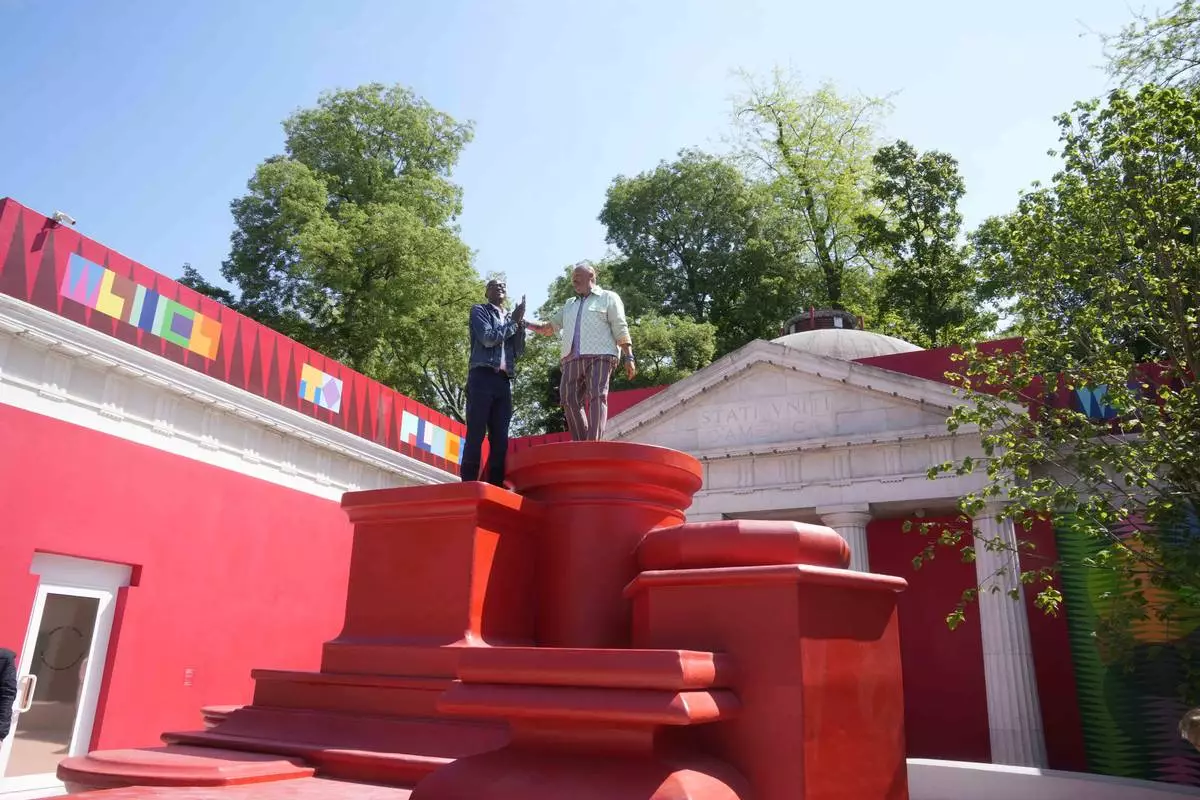
Artist Jeffrey Gibson, right, poses with artist Mark Bradford at the U.S. pavilion during the media open day at the 60th Biennale of Arts in Venice, Italy, Tuesday, April 16, 2024. A Mississippi Choctaw of Cherokee descent, Gibson is the first Native American to represent the United States solo at the Venice Biennale, the world’s oldest contemporary art show. Gibson mixes Western modernism and Native American craft in his vibrantly hued paintings and sculptures. (AP Photo/Luca Bruno)
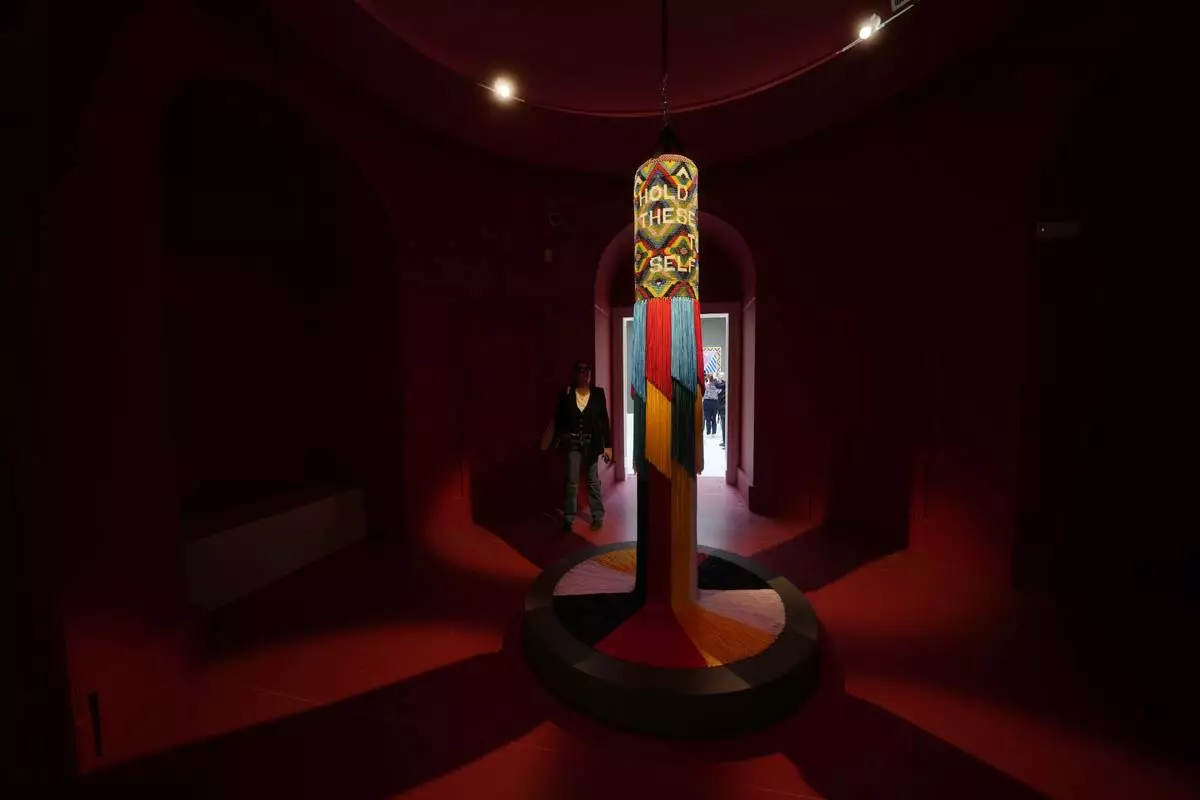
Visitors look at sculptures on display inside the US pavilion by artist Jeffrey Gibson during the 60th Biennale of Arts in Venice, Italy, Tuesday, April 16, 2024. A Mississippi Choctaw of Cherokee descent, Gibson is the first Native American to represent the United States solo at the Venice Biennale, the world’s oldest contemporary art show. Gibson mixes Western modernism and Native American craft in his vibrantly hued paintings and sculptures. (AP Photo/Luca Bruno)
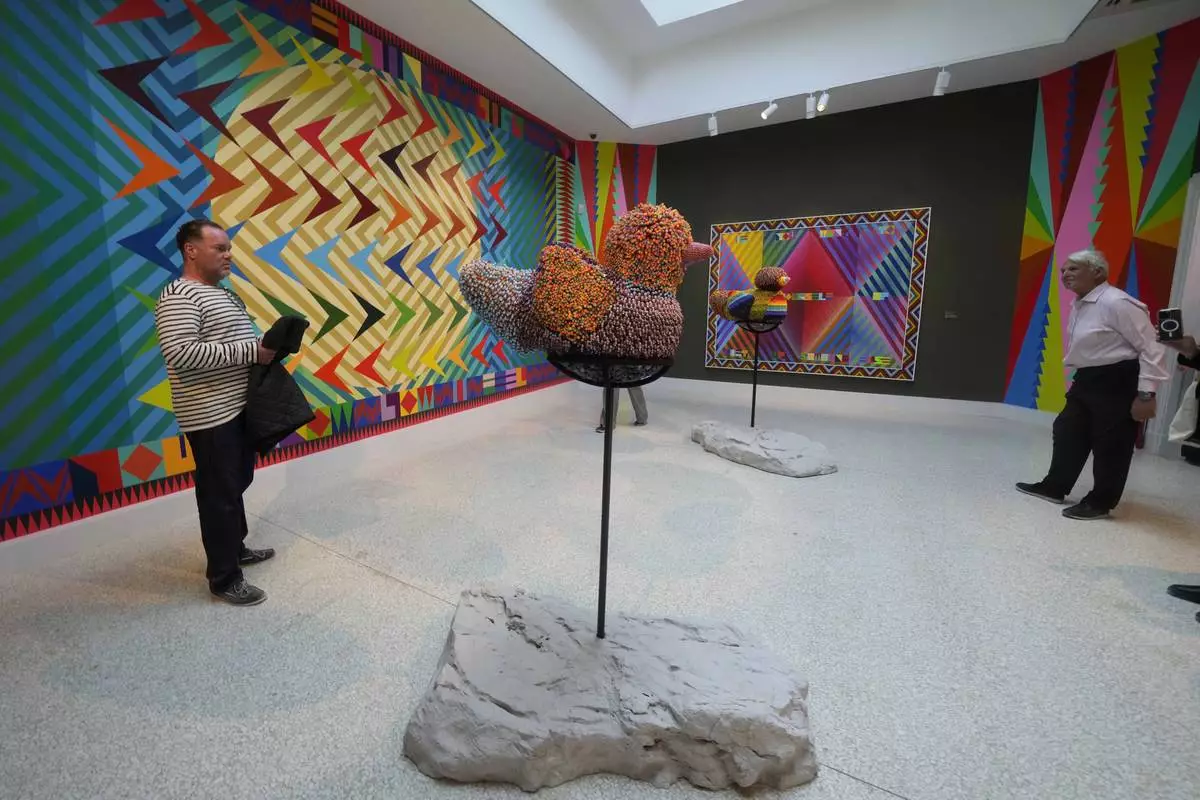
Visitors look at sculptures on display inside the US pavilion by artist Jeffrey Gibson during the 60th Biennale of Arts in Venice, Italy, Tuesday, April 16, 2024. A Mississippi Choctaw of Cherokee descent, Gibson is the first Native American to represent the United States solo at the Venice Biennale, the world’s oldest contemporary art show. Gibson mixes Western modernism and Native American craft in his vibrantly hued paintings and sculptures. (AP Photo/Luca Bruno)

Visitors look at sculptures on display inside the US pavilion by artist Jeffrey Gibson during the 60th Biennale of Arts in Venice, Italy, Tuesday, April 16, 2024. A Mississippi Choctaw of Cherokee descent, Gibson is the first Native American to represent the United States solo at the Venice Biennale, the world’s oldest contemporary art show. Gibson mixes Western modernism and Native American craft in his vibrantly hued paintings and sculptures. (AP Photo/Luca Bruno)

Visitors look at sculptures on display inside the US pavilion by artist Jeffrey Gibson during the 60th Biennale of Arts in Venice, Italy, Tuesday, April 16, 2024. A Mississippi Choctaw of Cherokee descent, Gibson is the first Native American to represent the United States solo at the Venice Biennale, the world’s oldest contemporary art show. Gibson mixes Western modernism and Native American craft in his vibrantly hued paintings and sculptures. (AP Photo/Luca Bruno)
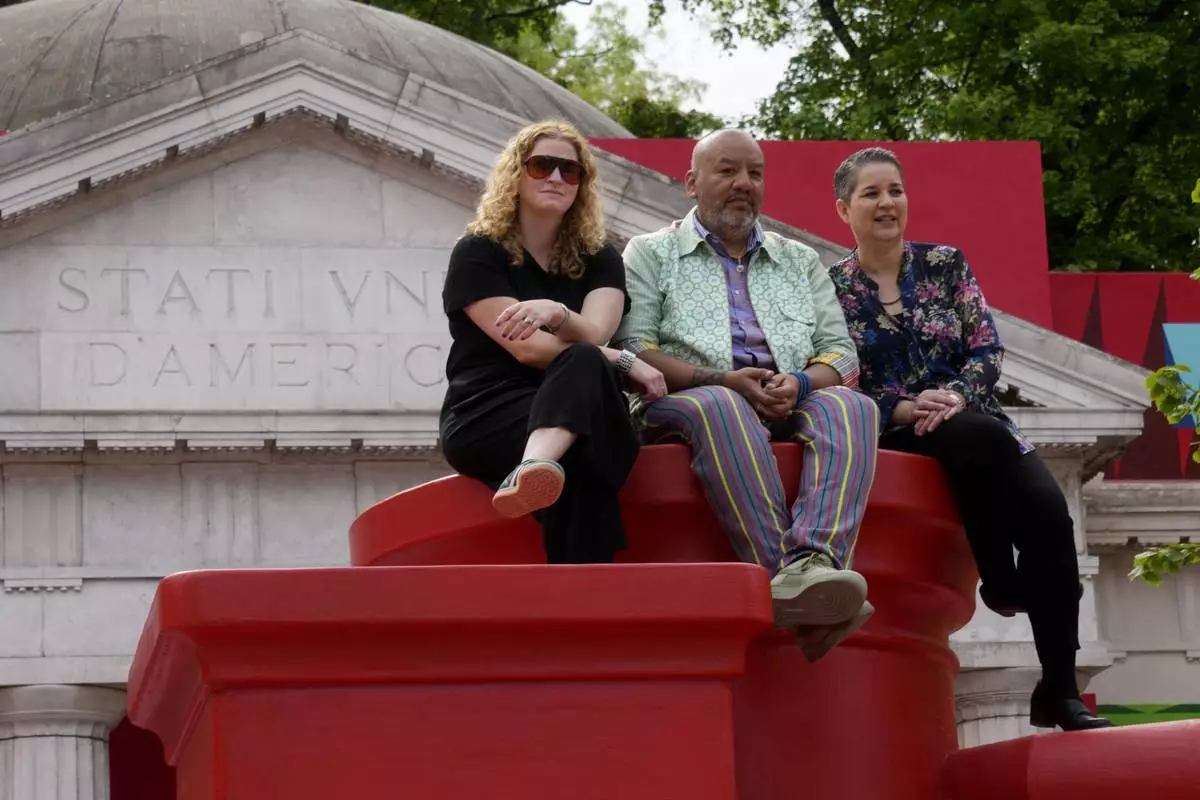
From left, Curator Abigail Winograd, artist Jeffrey Gibson, and Curator Kathleen Ash-Milby pose at the US pavilion during the media open day at the 60th Biennale of Arts in Venice, Italy, Tuesday, April 16, 2024. A Mississippi Choctaw of Cherokee descent, Gibson is the first Native American to represent the United States solo at the Venice Biennale, the world’s oldest contemporary art show. Gibson mixes Western modernism and Native American craft in his vibrantly hued paintings and sculptures. (AP Photo/Luca Bruno)
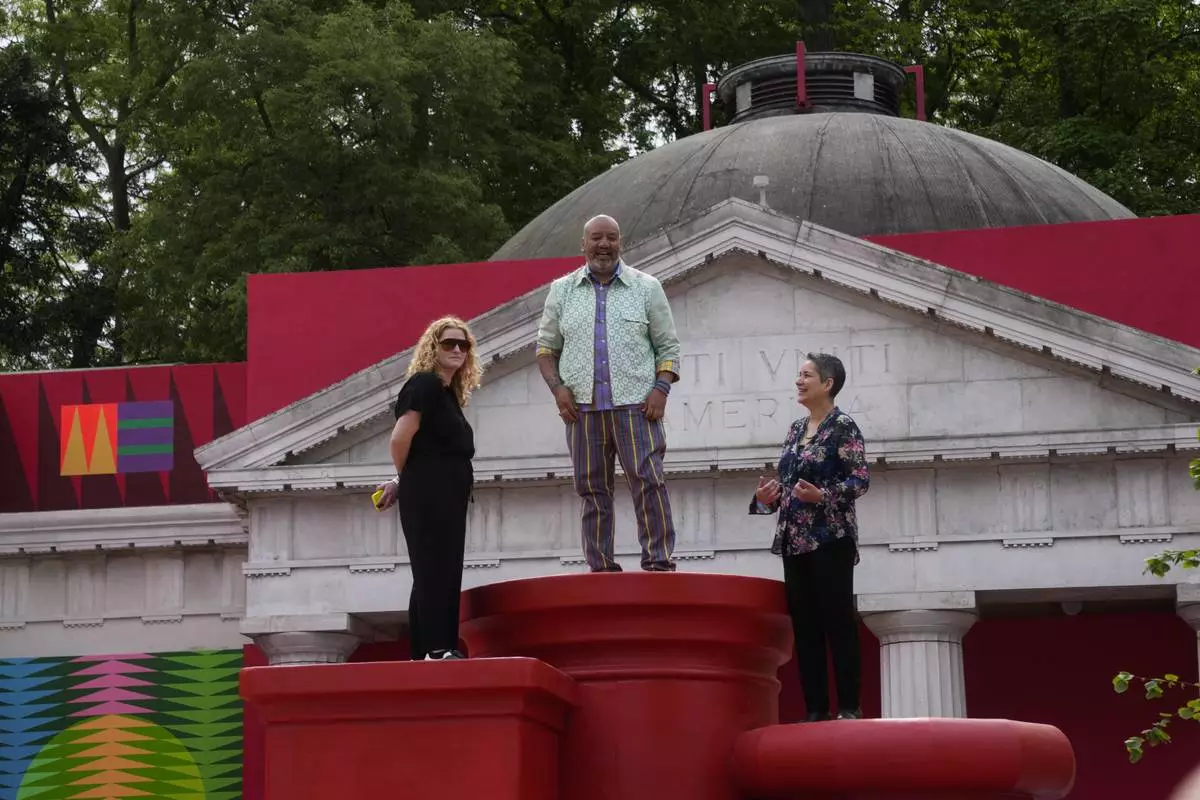
From left, Curator Abigail Winograd, artist Jeffrey Gibson, and Curator Kathleen Ash-Milby pose at the US pavilion during the media open day at the 60th Biennale of Arts in Venice, Italy, Tuesday, April 16, 2024. A Mississippi Choctaw of Cherokee descent, Gibson is the first Native American to represent the United States solo at the Venice Biennale, the world’s oldest contemporary art show. Gibson mixes Western modernism and Native American craft in his vibrantly hued paintings and sculptures. (AP Photo/Luca Bruno)
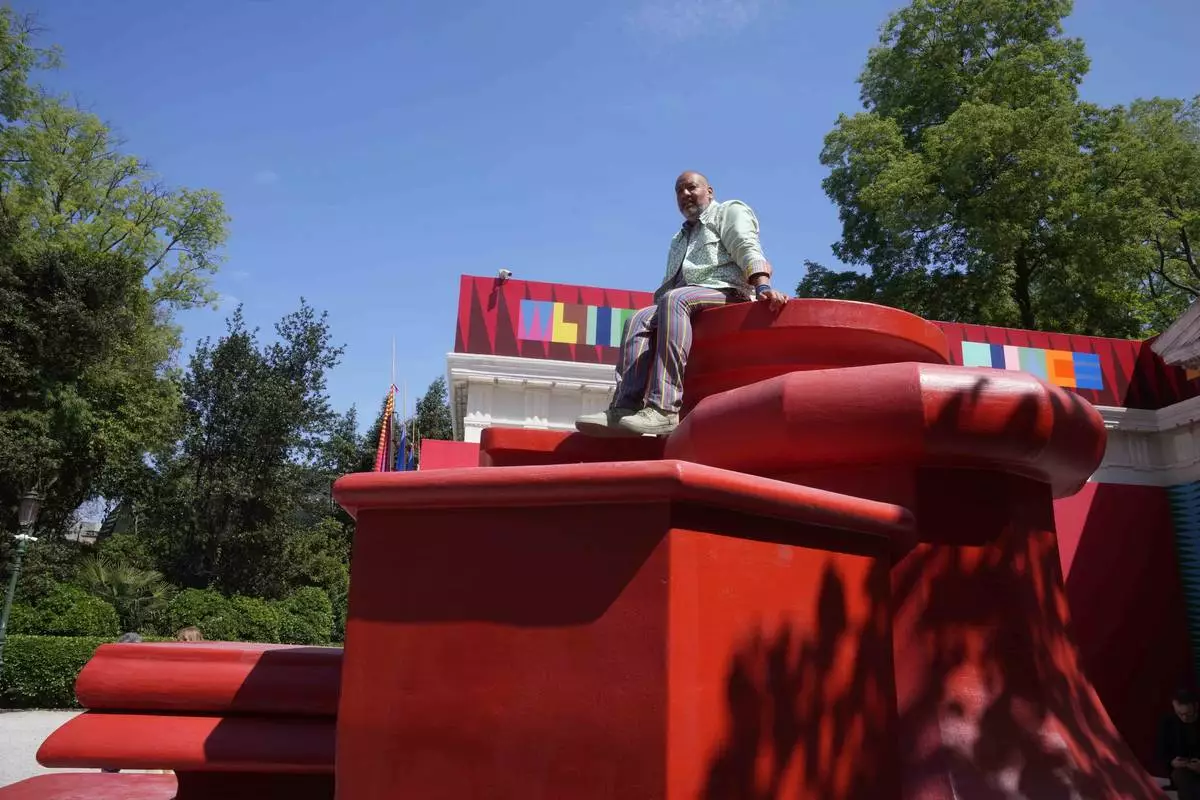
Artist Jeffrey Gibson poses at the US pavilion during a media open day at the 60th Biennale of Arts in Venice, Italy, Tuesday, April 16, 2024. A Mississippi Choctaw of Cherokee descent, Gibson is the first Native American to represent the United States solo at the Venice Biennale, the world’s oldest contemporary art show. Gibson mixes Western modernism and Native American craft in his vibrantly hued paintings and sculptures. (AP Photo/Luca Bruno)
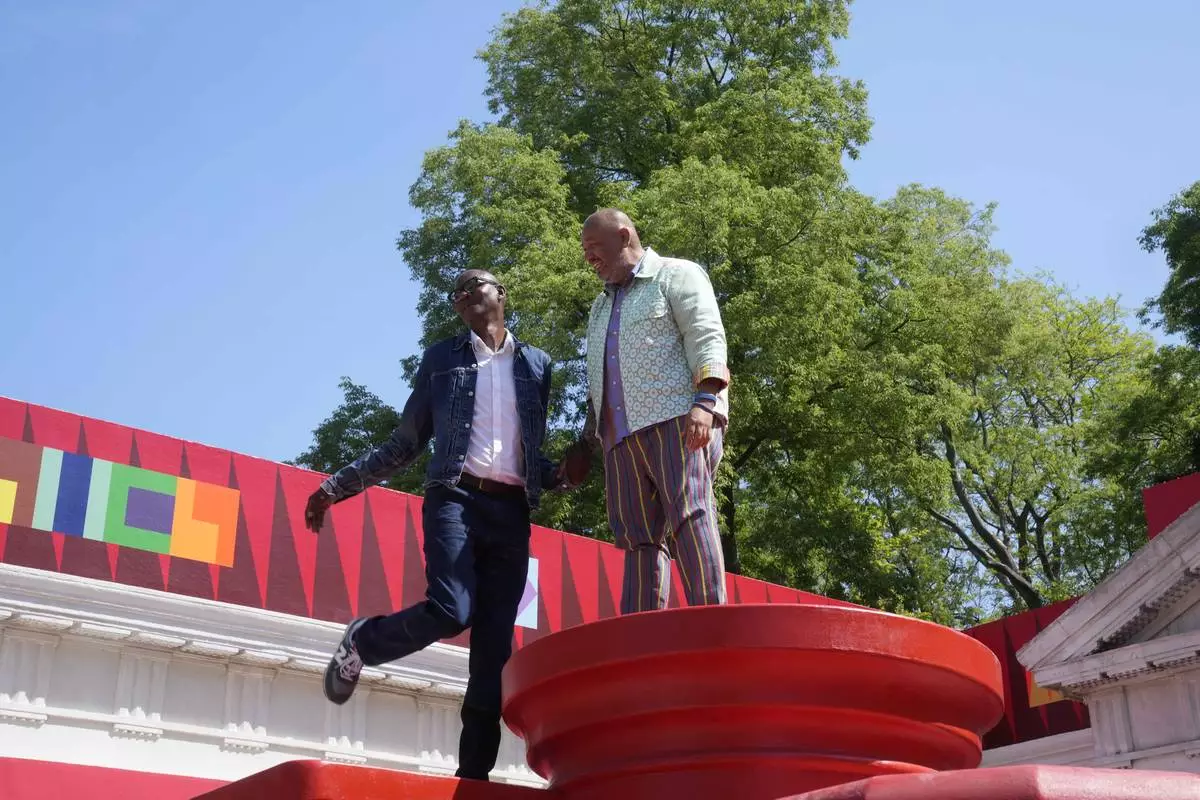
Artist Jeffrey Gibson, right, poses with artist Mark Bradford at the U.S. pavilion during the media open day at the 60th Biennale of Arts in Venice, Italy, Tuesday, April 16, 2024. A Mississippi Choctaw of Cherokee descent, Gibson is the first Native American to represent the United States solo at the Venice Biennale, the world’s oldest contemporary art show. Gibson mixes Western modernism and Native American craft in his vibrantly hued paintings and sculptures. (AP Photo/Luca Bruno)
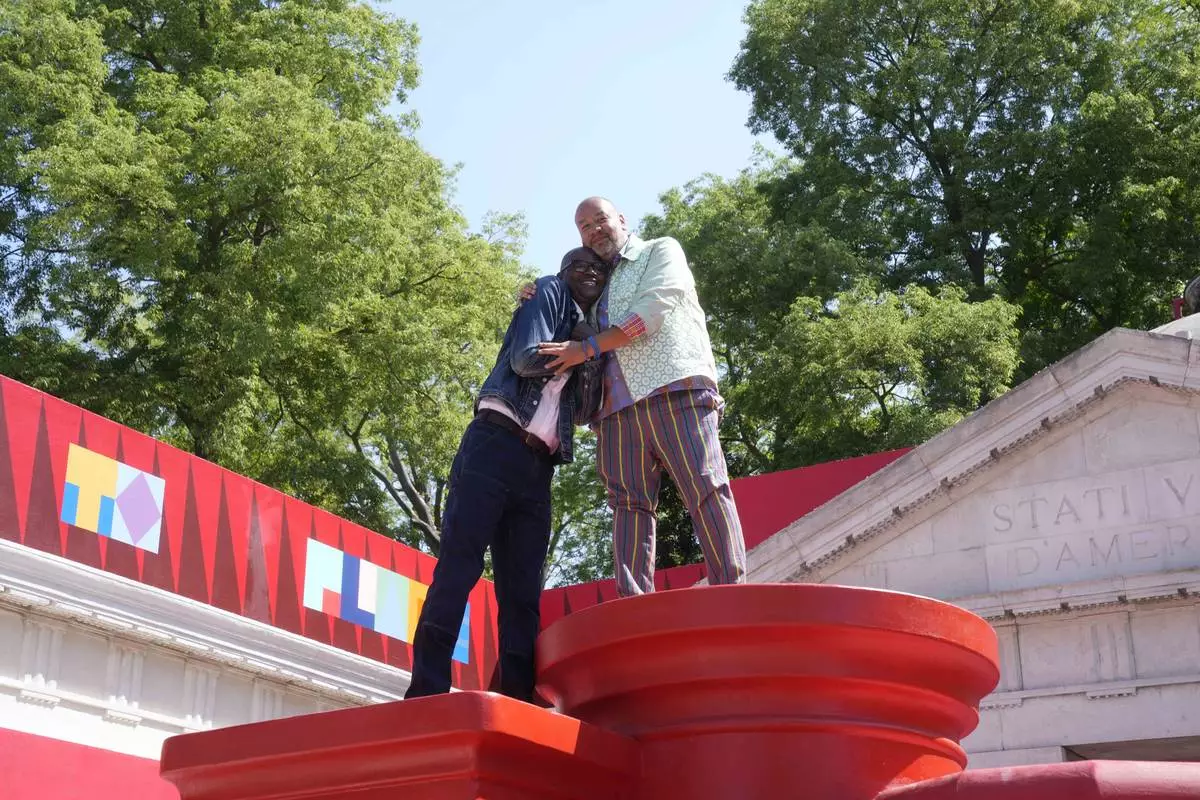
Artist Jeffrey Gibson, right, hugs artist Mark Bradford at the U.S. pavilion during media open day of the 60th Biennale of Arts exhibition in Venice, Italy, Tuesday, April 16, 2024. A Mississippi Choctaw of Cherokee descent, Gibson is the first Native American to represent the United States solo at the Venice Biennale, the world’s oldest contemporary art show. Gibson mixes Western modernism and Native American craft in his vibrantly hued paintings and sculptures. (AP Photo/Luca Bruno)
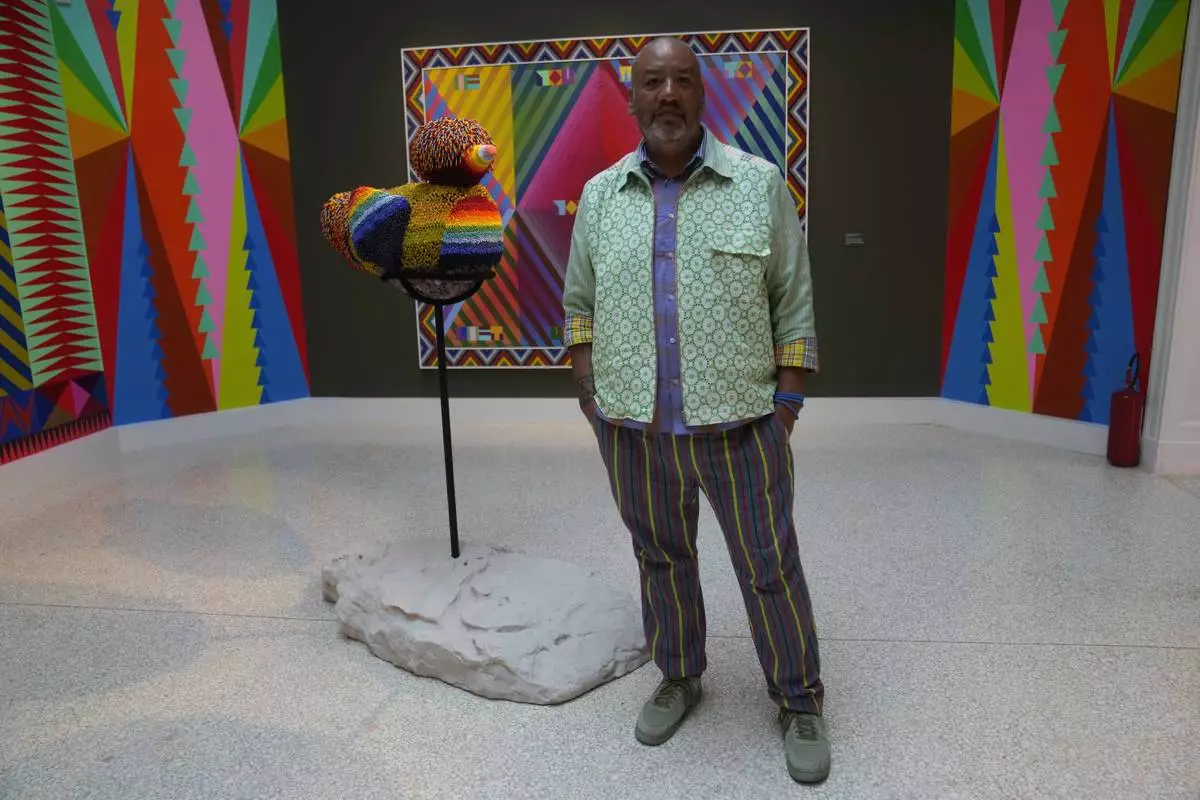
Artist Jeffrey Gibson poses inside the US pavilion during the media open day at the 60th Biennale of Arts in Venice, Italy, Tuesday, April 16, 2024. A Mississippi Choctaw of Cherokee descent, Gibson is the first Native American to represent the United States solo at the Venice Biennale, the world’s oldest contemporary art show. Gibson mixes Western modernism and Native American craft in his vibrantly hued paintings and sculptures. (AP Photo/Luca Bruno)



















